Anti-aircraft self-propelled installation Versuchsflakwagen 8.8cm FlaK auf Sonderfahrgestell (Germany)
History 8.8cm FlaK auf Sonderfahrgestell project dates back to the initial period of the war in Europe, when German gunners found that 88-mm guns of the FlaK 18 family are capable of hitting not only enemy aircraft, but also various armored vehicles. The large caliber and high muzzle energy of the projectiles made it possible to literally flash the armor of most of the tanks of that time. In the future, several options for installing anti-aircraft guns on various chassis of existing models appeared, which allowed them to be used to combat enemy armored vehicles. Some of this technology was able to reach operation in the military, but did not show significant results. The fact is that guns of 88 caliber mm were very heavy and had a big recoil impulse. These factors seriously reduced the list of potential carriers, and also negatively affected the construction resource of the latter.
In 1942, Krupp proposed to develop a special chassis that could carry heavy powerful weapons and effectively solve the tasks of anti-tank defense using Flak 18 cannons, etc. weapons. The proposal was approved by the potential customer and led to the start of the project. Perspective self-propelled chassis received the designation Sonderfahrgestell ("Special chassis") or Pz.Sfl.IV (c). To speed up development and simplify production, it was decided to maximize the unification of the new chassis with existing and under development tanks of several types.
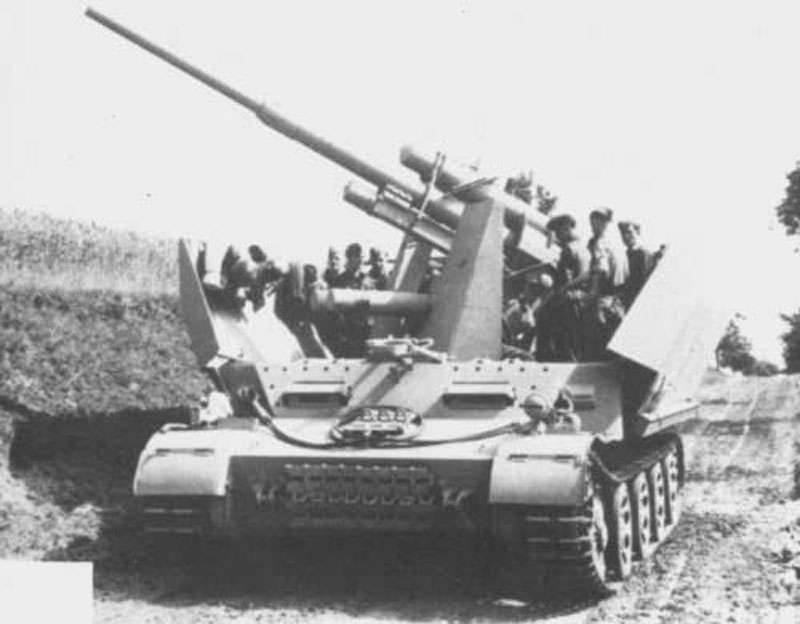
ZSU 8.8cm FlaK auf Sonderfahrgestell in a combat position. Boards down, gun raised. Photo Aviarmor.net
On the chassis, it was proposed to mount an armored cabin, inside which should be placed 88-mm gun. Such a combat vehicle could become a relatively simple and effective means of fighting enemy tanks and supplement other armored vehicles of the troops. However, soon after the completion of the preliminary work, the project of a promising anti-tank SAU changed its purpose.
Analysis of the proposed development showed that in its current form, it no longer meets the requirements for such a technique. Observed and expected changes in the enemy’s technology did not allow us to hope that the proposed ACS based on Sonderfahrgestell would be able to effectively deal with enemy tanks without significant risks to themselves. At the same time, the car, with some special modifications, could easily solve the tasks of the air defense. The use of the Flak 18 family of guns gave a high efficiency to hitting targets, and the presence of a self-propelled chassis dramatically increased mobility and overall machine performance.
In the autumn of 1942, Krupp completed the reworking of a new self-propelled gun project, which was now intended to participate in air defense. Shortly thereafter, on one of the new chassis of the promising model, an instrument and a number of other additional equipment were mounted. By the end of the year, the first sample of a promising anti-aircraft self-propelled unit was ready for testing. At this stage, the designation 8.8cm FlaK auf Sonderfahrgestell appeared. In addition, the Versuchsflakwagen 8.8cm FlaK auf Sonderfahrgestell (Pz.Sfl.IVc), a more volumetric designation, was used: “Experimental anti-aircraft installation with 8,8 cm anti-aircraft gun based on the Special chassis.”
Prospective chassis for new self-propelled artillery systems were developed with extensive use of developments in the existing technology. In particular, the Sonderfahrgestell machine resembled the Pz.Kpfw.V Panther and Pz.Kpfw.VI Tiger tanks in general hull lines and chassis design. This similarity was due to the use of similar ideas, and the use of some finished products.
"Special chassis" was originally created as a special self-propelled platform for the installation of weapons, which affected its design. The body of the car had a small height, and the central part of the roof was a platform for installing the necessary systems. At the same time, a small cabin with a management compartment, which had a multifaceted form, was envisaged in front of the gun platform, and a large superstructure of the engine compartment was located in the stern. Such a housing design with a lowered roof allowed, to a certain extent, to reduce the overall height of the vehicle in comparison with the chassis of the “tank” layout.
Inside the hull provided only two jobs for crew members. Under the front of the wheelhouse should have been located a driver and radio operator. To observe the situation and the road, they had four viewing devices of a slit construction: two were located in the front cutting plate, two more - in the cheekbones. It was proposed to install two hatches in the roof of the cabin to get inside the car. Between the hatches, the gun mount device was movably mounted in the stowed position.
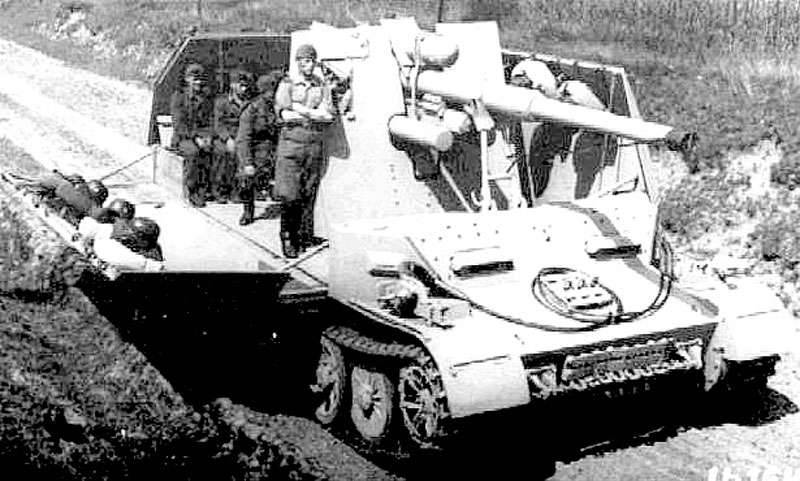
Self-propelled gun in preparation for shooting. It can be seen that the engine compartment cover was used as a shop for gunners. Photo Blog.tankpedia.org
The chassis body was proposed to be assembled from armor plates of different thickness. The frontal projection of the machine received protection in the form of 50-mm sheets, while the protection of the sides and stern was carried out with armor thickness 20 mm. The roof and bottom were two times thinner than the sides. Initially it was assumed that such a booking would allow an anti-tank self-propelled gun to work on the front lines in some combat formations with tanks and other armored vehicles. After changing the destination of the perspective machine, the design of the armored hull has not undergone any changes.
Based on existing ideas and aggregates, the Sonderfahrgestell machine had a layout that was standard for German tanks of the time. In front of the case there was a compartment for placing the transmission units, next to which was the control compartment. The central part of the chassis was given under the placement of the gun, which was supposed to be mounted on the roof of the hull. The engine and some related equipment were placed in the stern. The connection of the engine with the gearbox and other transmission units was ensured by a cardan shaft passing through the entire body.
The “Special Chassis” received a power plant based on the Maybach HL12 petrol 90-cylinder engine with an 360 hp power. The main element of the transmission was a six-speed manual gearbox. Like the German tanks of the time, the transmission transmitted the engine torque to the front drive wheels.
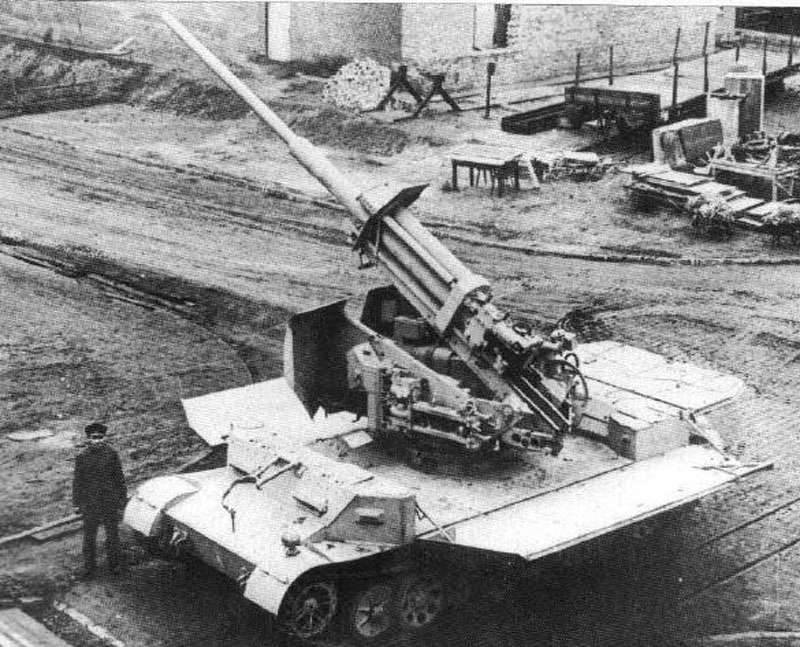
8.8cm FlaK auf Sonderfahrgestell in a combat position. Photo Blog.tankpedia.org
The undercarriage of a promising combat vehicle was developed taking into account the developments of the designs of the Tiger and Panther tanks. On each side of the new chassis there were eight dual support rollers, arranged in a staggered manner and partially overlapping each other (the so-called G. Knipkamp suspension). Also included were front drive wheels raised relative to the rollers (this led to the characteristic shape of the front of the track), as well as rear guides. Due to the large diameter of the road wheels, the running gear did not need support rollers. The caterpillar had a width of 520 mm and had a coarse structure.
The main weapons The 88-mm FlaK 18 anti-aircraft gun was supposed to be a prospective ZSU (some sources indicate its later version of the FlaK 37). This instrument was proposed to be mounted on the upper platform of the hull using a slightly modified mast of the basic design. For this, the carriage had to lose beds intended to be deployed on the ground, and rely with its rotary unit directly on the corresponding parts of the hull. After completion, the carriage retained all the guidance mechanisms with manual drives, armor shield with a sloping frontal sheet and small side, as well as a balancing mechanism and other units. Due to the use of ready-made units, the possibility of horizontal pickup in any direction and raising the barrel from -3 ° to + 85 ° was saved.
88-mm gun, proposed for use on the new ZSU, had a barrel length 56 calibers and equipped with a horizontal wedge gate. The semi-automatic mechanism ensured the extraction of spent cartridges and the cocking of the gun before firing, thanks to which a trained calculation could do up to 15-20 shots per minute. With an initial projectile speed of up to 840 m / s, the guns of the FlaK 18 family could hit air targets at altitudes up to 10 km and fire on ground targets at a distance of about 14-15 km. The ammunition consisted of fragmentation and armor-piercing shells of several types.
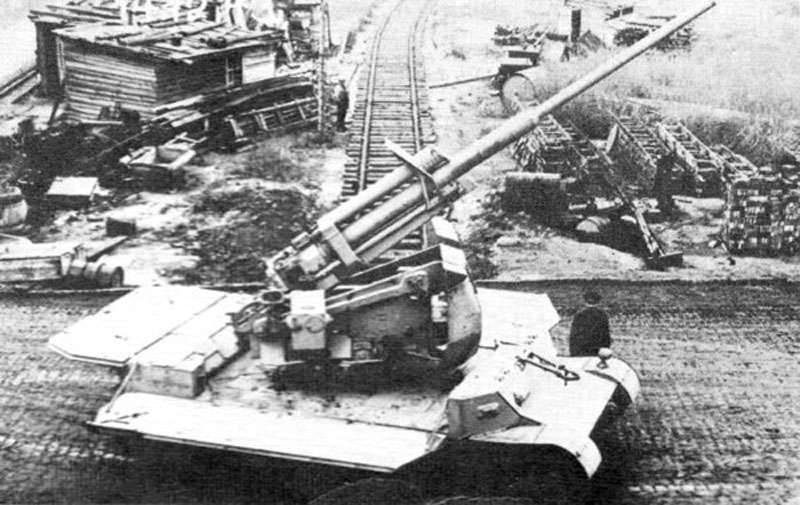
Self-propelled gun in a combat position from a different angle. Photo Blog.tankpedia.org
In the stowed position, the gun was to turn the barrel forward and stop in that position. The barrel was fixed on a special frame installed on the front wheelhouse. In preparation for the shooting, the calculation was supposed to free the barrel and remove the stoppers of the guidance systems.
To work at the forefront of the ZNU 8.8 cm FlaK auf Sonderfahrgestell should have additional protection for the gun and its calculation. Together with the cannon, the car was to receive an armor shield of the existing structure, covering the calculation from bullets and fragments from the front hemisphere. Sheets of such a shield had a thickness of 10 mm.
The side and rear of the gunners were supposed to protect the armored cabin, also assembled from 10-mm sheets. It had sides with a vertical bottom and an upper part littered inside. In front of the sides, small sheets were fastened at an angle, covering the gap between the sides and the shield of the gun. Also, the felling received a stern leaf, the shape of which provided a close connection with the rear part of the sides. The roof of the cabin was not provided. In case of bad weather, the crew of the car had a canvas awning. All the elements of the cabin were attached to the body of the hinge, so that the crew, if necessary, could throw them at a certain angle. At the minimum angles of opening of the sides, the sector of horizontal guidance of the gun increased, and in the fully lowered form they turned into a platform for calculation and allowed circular firing. The stern leaf of the cabin, as well as the boards, could be lowered into a horizontal position, after which it did not impede firing into the rear hemisphere.
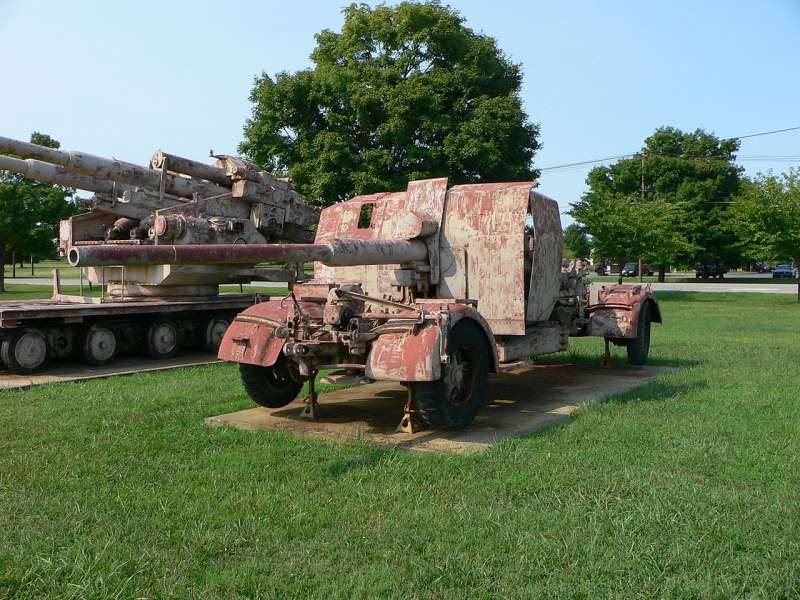
Flak 41 cannon is the main weapon of the upgraded ZNS 8.8cm FlaK auf Sonderfahrgestell. Photo of Wikimedia Commons
Inside the armored felling there was a place for the transport of ammunition, consisting of unitary shells of 88 caliber mm of various types and for different purposes. Also, the self-propelled gun could fire with the supply of ammunition from the ground. At the same time, however, it was necessary to lay out the boards for the convenience of transferring projectiles and supplement the calculation of the gun with several numbers.
The anti-aircraft self-propelled crew was to consist of five or seven or eight people. When working as an anti-tank ACS or when using portable ammunition packed in the wheelhouse, the work should have been controlled by a driver, radio operator, commander, gunner, and loader. For submission of shells from the ground in the calculation of the gun had to include two or three carriers.
The finished self-propelled gun of the new model was supposed to have a mass of combat at the level of 26 t and in its dimensions correspond to the majority of German tanks of that time. The length of the machine without taking into account the gun did not exceed 8 m, the width reached 3 m, and the height was 2,8 m.
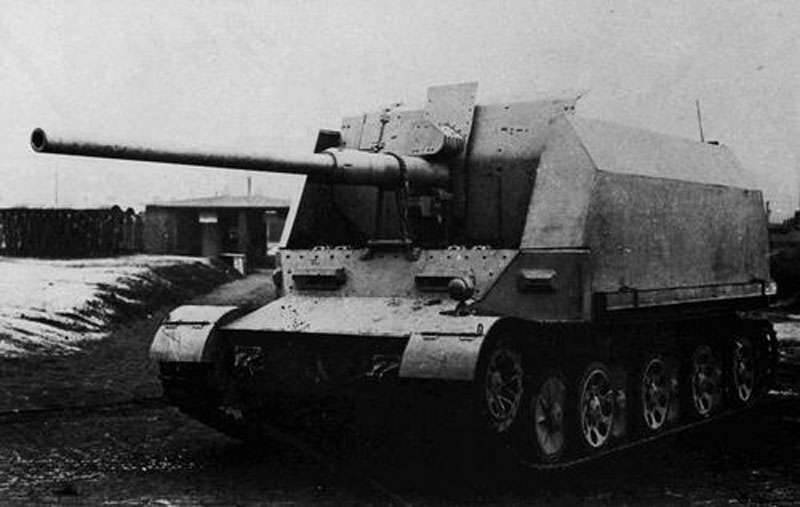
Updated self-propelled gun in the stowed position. Photo Aviarmor.net
According to reports, the design of a promising ZSU 8.8 cm FlaK auf Sonderfahrgestell with an 88-mm tool was completed in the autumn of 1942. Shortly thereafter, at one of the Krupp factories, the first chassis of a new type was assembled, which received an anti-aircraft gun such as the FlaK 18. The first tests showed that the “Special Chassis” turned out to be a fairly successful basis for advanced equipment for various purposes. With a power density slightly less than 14 hp per ton the armored vehicle could reach speeds up to 35 km / h on the highway. Power reserve was determined in 200 km. The firepower of the ZSU did not differ from the corresponding guns in the original towed form.
The new self-propelled self-propelled gun has been tested and has shown quite high performance. Such equipment could be of great interest to the troops, but the military decided otherwise. By the time the tests were completed at the beginning of 1943, the potential customer decided that the existing version of the 8.8 cm FlaK auf Sonderfahrgestell ZSU did not fully meet the requirements of the time. The main claims related to the used gun FlaK 18, which was already considered obsolete. It was proposed to create a new version of the armored vehicle with a newer instrument of similar purpose and caliber, but differing in enhanced performance.
In 1943, the Krupp design bureau began to modernize its design with the aim of using new weapons. Now on the “Special Chassis” it was proposed to install the Flak 41 cannon, which was a further development of the guns of the previous models. Due to a number of innovations, including a new projectile with enhanced characteristics and a barrel with a length of 72 or 74 caliber (depending on the series), the Flak 41 gun could shoot at a greater distance. In particular, the maximum shooting height reached 15 km. The new gun was completed with another carriage with other characteristics. Thus, the elevation angles of FlaK 41 varied from -3 ° to + 90 °.
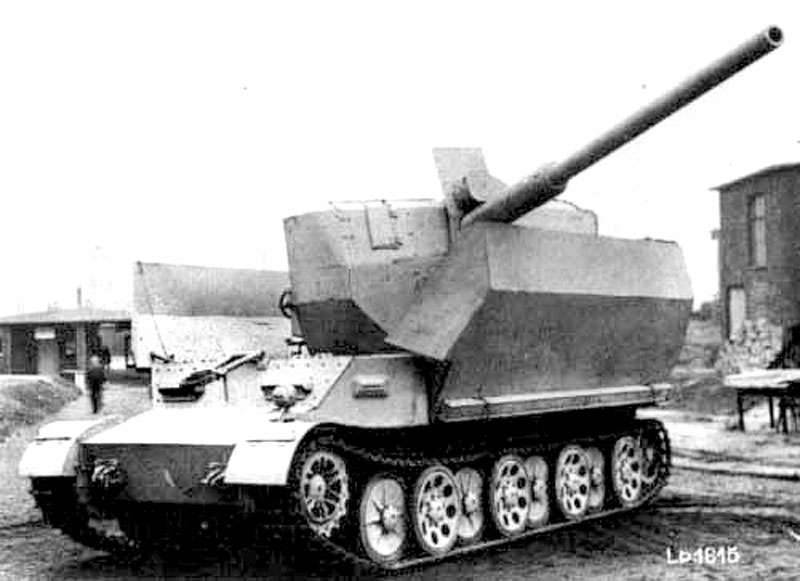
The boards are not fully lowered, but the FlaK 41 gun has the ability to fire at air targets. Photo Blog.tanlpedia.org
The use of a new weapon made it possible to preserve the existing mobility of the ZSU, but at the same time it markedly increased its combat effectiveness due to an increase in the range and height of the targets. Nevertheless, the production of the Flak 41 cannons was faced with noticeable problems, which is why the pace of release left much to be desired. Due to the complexity of the technological nature and high cost to the end of the war, a little more than 550 cannons of FlaK 41 were assembled. This weapon was immediately sent to the troops, which made it difficult to work on the self-propelled gun project. According to some data, only in 1944, the company-developer still managed to get the required tool of the new type and install it on the existing “Special chassis”, which was already used in the project. Together with the machine gun, they also installed a carriage of a new design with a new shield.
The most notable difference between the modernized armored 8.8cm FlaK auf Sonderfahrgestell from the first version was the armor shield of the guns of the new design. It was distinguished from the previous one by wide side sheets with a curved top and hatches for aiming, as well as narrow side sheets. In addition, together with the new shield, a movable mask of the gun was used, which included protection of the front part of the recoil devices. Due to the larger area, the new shield provided better cover for the gunners against possible threats on the battlefield.
Checks of the updated self-propelled guns that took place in the 1944 year showed a noticeable increase in the main characteristics and overall efficiency. However, in this case, the combat vehicle could not interest the command of the army. Probably, this time, the failure of the military was caused by insufficient rates of gun production, as well as by the peculiarities of the situation on the front, due to which the industry had to focus on other projects and reduce the cost of developing new weapons.
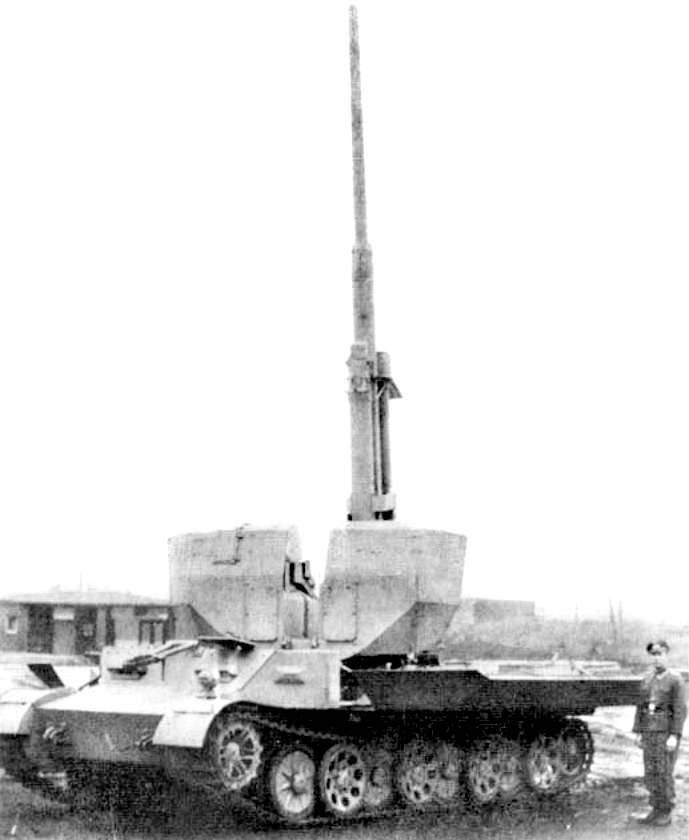
The gun is displayed at the maximum angle of elevation. Photo Blog.tankpedia.org
Due to the lack of prospects, the 8.8cm FlaK auf Sonderfahrgestell project was closed after testing the updated prototype. Subsequently, weapons were removed from it, and the chassis was used in the development of some new projects. On the basis of the “Special Chassis” it was proposed to build anti-tank and howitzer self-propelled guns, as well as anti-aircraft systems with small-caliber artillery systems. It is known that during one of the projects the Sonderfahrgestell machine was installed with an 37-mm automatic cannon. The option of a weapon transporter with a gun mount for the leFH43 howitzer lowered onto the ground for firing was also considered. Other variants of various artillery systems on the existing chassis were also proposed.
Despite all the efforts and time, effort and resources, the project of a promising anti-aircraft self-propelled gun with a 88-mm gun did not give noticeable results. Only one prototype was built, which at a certain stage was modernized and received a new weapon. In both cases, the proposed armored car did not suit the potential customer, who refused it for one reason or another. As a result, the army did not receive new ZSU with powerful weapons, and the promising chassis could not get out of the construction stage and test various new types of equipment.
In parallel with the 8.8cm FlaK auf Sonderfahrgestell in Germany, several other projects were being developed to install the FlaK 18 family of guns on a tracked chassis, but they also did not achieve significant success. With all its advantages, this technique had a lot of flaws, which led to failures on the part of potential customers. Thus, the project ZSU 8.8cm FlaK auf Sonderfahrgestell, failing, did not become the only example of a similar outcome of work in a promising area.
Based on:
http://achtungpanzer.com/
http://aviarmor.net/
http://blog.tankpedia.org/
http://panzer-journal.ru/
Chamberlain P., Doyle H. Complete reference book of German tanks and self-propelled guns of the Second World War. - M .: AST: Astrel, 2008.
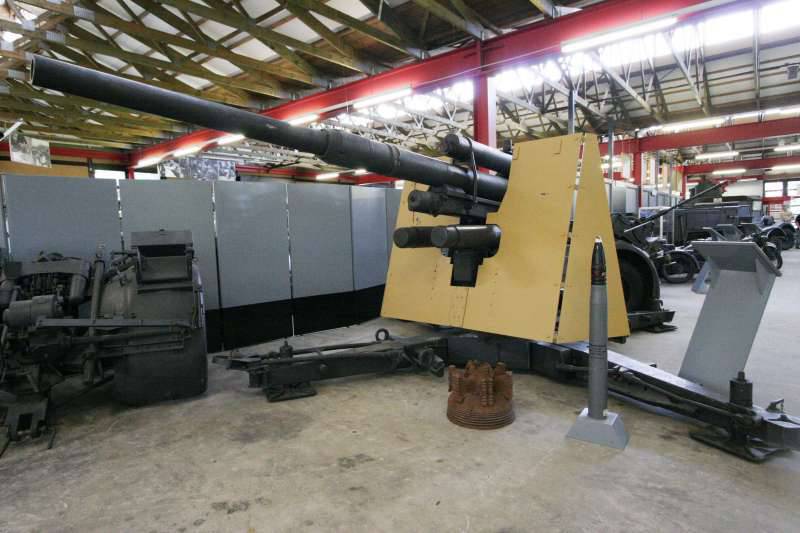
Information